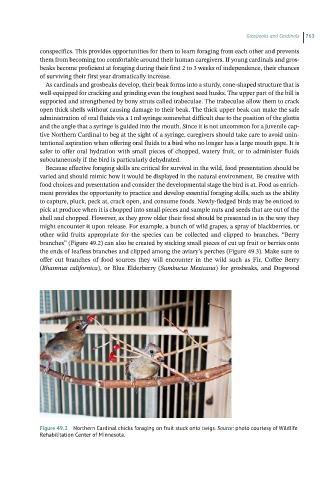Page 760 - Hand rearing birds second
P. 760
Grosbeaks and Cardinals 763
conspecifics. This provides opportunities for them to learn foraging from each other and prevents
them from becoming too comfortable around their human caregivers. If young cardinals and gros-
beaks become proficient at foraging during their first 2 to 3 weeks of independence, their chances
of surviving their first year dramatically increase.
As cardinals and grosbeaks develop, their beak forms into a sturdy, cone‐shaped structure that is
well‐equipped for cracking and grinding even the toughest seed husks. The upper part of the bill is
supported and strengthened by bony struts called trabeculae. The trabeculae allow them to crack
open thick shells without causing damage to their beak. The thick upper beak can make the safe
administration of oral fluids via a 1 ml syringe somewhat difficult due to the position of the glottis
and the angle that a syringe is guided into the mouth. Since it is not uncommon for a juvenile cap-
tive Northern Cardinal to beg at the sight of a syringe, caregivers should take care to avoid unin-
tentional aspiration when offering oral fluids to a bird who no longer has a large mouth gape. It is
safer to offer oral hydration with small pieces of chopped, watery fruit, or to administer fluids
subcutaneously if the bird is particularly dehydrated.
Because effective foraging skills are critical for survival in the wild, food presentation should be
varied and should mimic how it would be displayed in the natural environment. Be creative with
food choices and presentation and consider the developmental stage the bird is at. Food as enrich-
ment provides the opportunity to practice and develop essential foraging skills, such as the ability
to capture, pluck, peck at, crack open, and consume foods. Newly‐fledged birds may be enticed to
pick at produce when it is chopped into small pieces and sample nuts and seeds that are out of the
shell and chopped. However, as they grow older their food should be presented in in the way they
might encounter it upon release. For example, a bunch of wild grapes, a spray of blackberries, or
other wild fruits appropriate for the species can be collected and clipped to branches. “Berry
branches” (Figure 49.2) can also be created by sticking small pieces of cut up fruit or berries onto
the ends of leafless branches and clipped among the aviary’s perches (Figure 49.3). Make sure to
offer cut branches of food sources they will encounter in the wild such as Fir, Coffee Berry
(Rhamnus californica), or Blue Elderberry (Sambucus Mexicana) for grosbeaks, and Dogwood
Figure49.2 Northern Cardinal chicks foraging on fruit stuck onto twigs. Source: photo courtesy of Wildlife
Rehabilitation Center of Minnesota.

